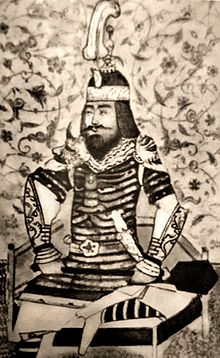तिमुर
| Tarmashirin Khan Barlas | |
|---|---|
| अमिर | |
 A Timurid era illustration of Emir Timur | |
| शासन | 1370–1405 |
| गद्दीरोहण | 1370, Balkh |
| पदवी | Timur Lung (Timur the Lame),Beg, Khan, Mirza, Gurkani |
| बुगु तिथि | 9 अप्रिल सन् 1336 |
| बुगु थाय् | Kesh, Chagatai Khanate (Now in Uzbekistan) |
| मदूगु तिथि | 18 फेब्रुवरी 1405 (आयु 68) |
| मदूगु थाय् | Otrar, Syr Darya (Now in Kazakhstan) |
| समाधि | Gur-e Amir, Samarkand |
| पूर्वाधिकारी | अमिर हुसैन |
| उत्तराधिकारी | खलिल सुल्तान |
| घराना | तिमुरिद |
| अबु | मुहम्मद ताराघाइ |
| मा | तेकिना मोहबेगिम |
| धर्म | मुस्मां |
तिमुर, तर्मशिरिन खान, अमिर तिमुर (पारसी: تیمور Timūr, Chagatai: Temür "iron"; अप्रिल ९, सन् १३३६ – फेब्रुवरी १८, सन् १४०५), ऐतिहासिर रुपं तमेरलेनया नामं नांजाम्ह[१] (पारसी: تيمور لنگ, Timūr-i Lang भासय्, Aksak Timur "तिमुर लंगदा " तर्किश भासय्), छम्ह तर्किक शासक ख।[२][३][४] वय्कलं पश्चिम एसिया, दक्षिण एसिया व मध्य एसिया थःगु अधीनय् लाका तिमुरिद वंश पलिस्था यानादिल। वय्कः उलुघ बेगया अजा ख। उलुघ बेगं मध्य एसिया सन् १४११ निसें सन् १४४९ तक्क राज यानादिल। [५][६][७] नापं, वय्कः भारतया मुघल वंश पलिस्था यानादिम्ह बाबुरया तापाबाज्या ख। [८][९][१०][११][१२]
तिमुर छम्ह मंगोल ख। वय्कःया लक्ष्य गेंगिश खाननं पलिस्था यानादिगु मंगोल साम्राज्ययात पुनर्स्थापना यायेगु ख। [१३] न्हापायापिं मंगोल जुजु स्वया तिमुर थःगु धर्मं याना पाः, तिमुर मुस्मां धर्म हनिम्ह मनु ख व थःगु खलः व वय्कलं थःगु जीवनकालय् थःगु मंगोल भारदारतयेत मुस्मां धर्मय् हिलाछ्वल।[१४] वय्कःया सेना बहुजातीय सेना ख। थःगु जीवनय् वय्कः मुस्मां हलिमया दकलय् शक्तिशालि शासक जुयादिल, वय्कलं मिस्र व सिरियाया मम्लुकतेत, उदयीमान उस्मान साम्राज्य व पतन जुयाच्वंगु दिल्लीया सल्तनतयात थःगु जीवनकालय् बुकादिल। तिमुरं ख्रिस्ति नाइत्स हस्पितलरतेत स्मिर्नाय् बुकादिल व थःयात गाजीया रुपय् क्यनादिल।[१५] थःगु शासनया अन्तय् तिमुरं मंगोलतयेगु ल्यंगु चागाताइ खानेत, इल्खानेत, गोल्देन होर्दतेत थःगु अधीनय् लाकल धाःसा युवान साम्राज्ययात नं पुनर्स्थापना यायेगु कुतः यानादिल।
लिधंसा
[सम्पादन]- ↑ English pronunciation: /ˈtæmərleɪn/
- ↑ "Timur (Turkic conqueror)." Encyclopædia Britannica. Ultimate Reference Suite. Chicago: Encyclopædia Britannica, 2011, Online Edition.
- ↑ Josef W. Meri, Medieval Islamic Civilization, Routledge, 2005, p.812 Online Edition
- ↑ Massoume Price, Iran's Diverse Peoples: A Reference Sourcebook, ABC-CLIO, 2005, p. 56, quoted Belonging to a minor military family, and of Turkish origin, Timur was born in Transoxiana (present-day Uzbekistan) in the fourteenth century. He rose to prominence in the service of the local Mongol ruler, claimed to be descended from Chingiz-Khan, and defeated all competitors. Online Edition
- ↑ History of mathematics. By David Eugene Smith
- ↑ Science in Islamic civilisation: proceedings of the international symposia: "Science institutions in Islamic civilisation", & "Science and technology in the Turkish and Islamic world"[१]
- ↑ The global built environment as a representation of realities: By author:A.J.J. Mekking [२]
- ↑ "Timur", Encyclopædia Britannica, Online Academic Edition, 2007.
- ↑ "Central Asia, history of Timur", in Encyclopædia Britannica, Online Edition, 2007., Quotation: "... Timur first united under his leadership the Turko-Mongol tribes located in the basins of the two rivers...."
- ↑ History of Central Asia, Encyclopædia Britannica Online. 13 December 2008.
- ↑ B.F. Manz, "Tīmūr Lang", in Encyclopaedia of Islam.
- ↑ "Timur" The Columbia Encyclopedia, Sixth Edition, 2001–05. Quotation: Tamerlane, c.1336–1405, b. Kesh, near Samarkand. He is also called Timur Leng (Timur the lame). He was the son of a tribal leader, and a maternal descendant of Genghis Khan. He was from a Mongol tribe, Barlos. There were mongol tribes used to live in the area where his father was a leader. Timur spent his early military career in subduing his rivals in what is now Turkistan; by 1369 he firmly controlled the entire area from his capital at Samarkand.
- ↑ Beatrice Forbes Manz, Temür and the Problem of a Conqueror's Legacy, Journal of the Royal Asiatic Society, Third Series, Vol. 8, No. 1 (Apr., 1998), 25; "In his formal correspondance Temur continued throughout his life as the restorer of Chinggisid rights. He even justified his Iranian, Mamluk and Ottoman campaigns as a reimposition of legitimate Mongol control over lands taken by usurpers...".
- ↑ Michal Biran, The Chaghadaids and Islam: The Conversion of Tarmashirin Khan (1331–34) , Journal of American Oriental Society, Vol. 122, No. 4 (Oct. – Dec., 2002), 751; "Temur, a non-Chinggisid, tried to build a double legitimacy based on his role as both guardian and restorer of the Mongol Empire.".
- ↑ Marozzi, Justin (2004). Tamerlane: sword of Islam, conqueror of the world. Great Britain: HarperCollinsPublisher, 91.
स्वयादिसँ
[सम्पादन]| विकिमिडिया मंका य् थ्व विषय नाप स्वापु दुगु मिडिया दु: Timur |
